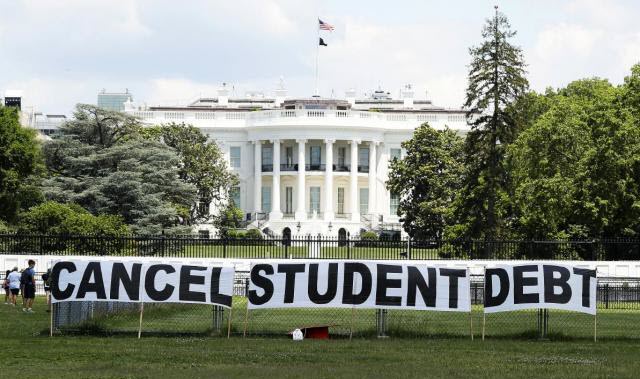Here’s a More Equitable Way to Lighten the Student Debt Load
Sep 3 2022President Biden's plan to waive $10,000 to $20,000 at an estimated cost of $300 billion across 10 years has expectedly drawn hosannas from Democrats and harangues from Republicans.
The view from the left is that the debt load of $1.6 trillion is a crushing burden weighing down one generation going on two that cries out for relief. With 7.65% in payroll taxes already taken from their paychecks (double that for the self-employed), another $400 or so drained from their bank accounts every month to repay their loans, former students are economically crippled well into adulthood. 
Because interest accrues faster than ability to pay, the average 35-year-old borrower owes $42,600, says Education Data Initiative. Young people forestall marriage, postpone having children, can afford only used cars, can't get a mortgage to buy a house. As well as stunting lives, student debt is a serious drag on the nation's economy.
Beyond alarm at yet another huge addition to the national debt transferred to taxpayers, the conservative position is that, however ill-conceived is the government program of handing out money indiscriminately to youths to spend at colleges of questionable quality, however misguided are students for taking out loans in tens of thousands of dollars for dead-end courses, debt is nevertheless a grown-up obligation that students must face up to.
Still, debt forgiveness that benefits only those who currently owe raises profound issues of inequity, an unavoidable argument. Canceling debt makes fools of those who struggled for years to repay all of their obligation, or those who worked their way through college to avoid debt only to see cancellation give others a free ride at government expense, or the tens of millions who forsook college, apprehensive of the debt burden, but who would be asked through their taxes to magnanimously pay for others who enjoyed the privilege of a college education.
Mr. Biden's plan is no sure thing. It is sure to be held up by legal challenges. So there is time and opportunity to consider a more equitable way
No one brings up the real burden: interest charges. America wants a well-educated workforce, whether in liberal arts, engineering, law, medicine, trade skills — any and all. Education is virtually the national mantra, universally cited as the path upward, the route to a better life, and essential to U.S. competitiveness in a challenging world. It's why there is a government student loan program. So why does the government make education so costly by charging interest on student loans?
The answer is that it makes money, which makes the federal government something of a confidence artist, peddling the virtues of education, making it easy for the young to take and spend loan money on a frivolous curriculum — there being hardly any guardrails — and treating students as a profit center by charging interest.
And at what rates! Among all borrowers, 5.8% is the average student loan interest rate and we see in the table that rates 
have run to over 4% in years when the federal funds rate was virtually 0%. How can this not be called exploitation of the young by Congress and the federal government?
"Congress has a hard time changing programs that make money for the government", said a Wall Street Journal article. Shaming Congress for profiteering off youth with a millstone that never should have been imposed could right this wrong.
Rather than a one-time, lump-sum cancellation of a tranche of debt, only for debt to rise again, elimination of interest provides a way to benefit every borrower — and in proportion to their debt. Here's how it could be done:
1. Cancel further interest and reverse past interest charges for everyone. Apply the entire payment history of each borrower to principal — the face value of one's loan — as if interest charges never existed. Other than refunding the difference to those whose accumulated payments exceed principal, no dollars flow. It's an accounting entry. Spread on both past and future payers, wiping out interest fairly benefits all.
2. With interest charges absent as an inducement to repay promptly, convert all loan repayment to a percentage of income (with stern penalties for evasion) until loan principal is paid in full. Low-income and public service workers will see their monthly payments sharply reduced. That should be consideration enough to end the special forgiveness programs whereby the government currently cancels debt after a certain number of years.
3. Waive the tax on forgiveness of debt on the grounds that interest charged to the young trying to get an education is an obscenity that should not have been levied in the first place.
The loan program faces steep costs in any event. In 2020 the Education Department estimated that $435 billion will eventually be written off owing to the forgiveness programs and to those who have no prospects for repaying. Given that eventuality, it makes sense to make the structural change of doing away with interest charges that benefits all and increases the likelihood that some millions of those having difficulty will be able to pay after all.
Please subscribe if you haven't, or post a comment below about this article, or
click here to go to our front page.

